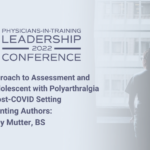Abstract | April 6, 2022
Osteopathic Approach to Assessment and Treatment of an Adolescent with Polyarthralgia in the Post-COVID Setting
Learning Objectives
- Diagnose and treat somatic dysfunction related to musculoskeletal pain complaints in adolescents in the post-COVID setting with OMM.
Introduction: As the COVID-19 pandemic completes year two, many questions remain regarding long term systemic effects of the virus. A major topic of discussion of the pandemic concerns chronic musculoskeletal pain conditions in the post-COVID setting. It has been observed that common chronic pain symptoms in the months following infection with SARS-CoV-2 include arthralgia, myalgia, and headaches [1]. Osteopathic Manipulative Medicine (OMM) continues to provide patients an excellent non-pharmacologic option for musculoskeletal pain conditions, particularly those experiencing polyarthralgia in the post-COVID setting.
Case Presentation: A 15-year-old male with history of COVID-19 infection presented to the OMM clinic for bilateral knee, bilateral hip pain, fatigue, and occasional headaches. The symptoms experienced by the patient began shortly following infection with COVID-19 in February 2021. The patient stated that over time the pain began to dissipate but came back following the COVID-19 vaccine two-shot series in August and September 2021. The patient described his pain as dull and achy, localized to the knee joints bilaterally as well as the hip joints bilaterally. No radiation of pain was noted. The pain has been the most significant following prolonged sitting, particularly at school.
Physical exam findings: positive Apley’s compression test on the right, Apley’s distraction test on the right, McMurray’s test bilaterally, FABERE test localized to the lateral hip, and IT band tenderness to palpation. Negative anterior drawer test bilaterally and posterior drawer test bilaterally. No deformity of the knees and full range of motion was noted of the knees bilaterally.
Laboratory results: positive ANA and negative RF.
Osteopathic structural exam: L unilateral extended sacrum, R anterior pelvis, R>L shoulder protraction, R>L IT band and TFL hypertonicity, B/L hamstring hypertonicity, B/L popliteal restriction, R>L hemidiaphragm inhaled, OA ESRRL, left side-bending rotation (cranial), R torsion (cranial), T8-12 NSLRR, L3-L5 NSLRR.
Working Diagnosis: Polyarthralgia in the post-COVID setting.
Management: OMM techniques including lymphatic treatment, counterstrain, muscle energy, articulatory techniques, balanced ligamentous tension (BLT), and osteopathy in the cranial field were used to assist with pain management and to help reduce inflammation around the effected joints. Patient and mother were also counseled on an anti-inflammatory diet.
References and Resources:
- Zayet S, Zahra H, Royer PY, et al. Post-COVID-19 Syndrome: Nine Months after SARS-CoV-2 Infection in a Cohort of 354 Patients: Data from the First Wave of COVID-19 in Nord Franche-Comté Hospital, France. Microorganisms. 2021;9(8):1719. Published 2021 Aug 12.

